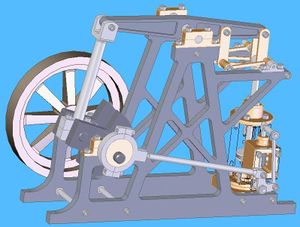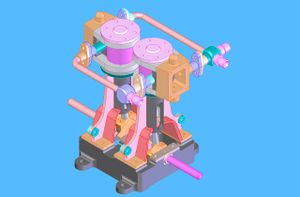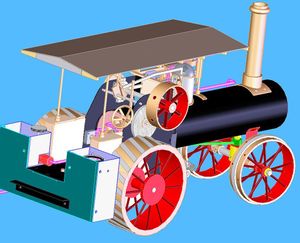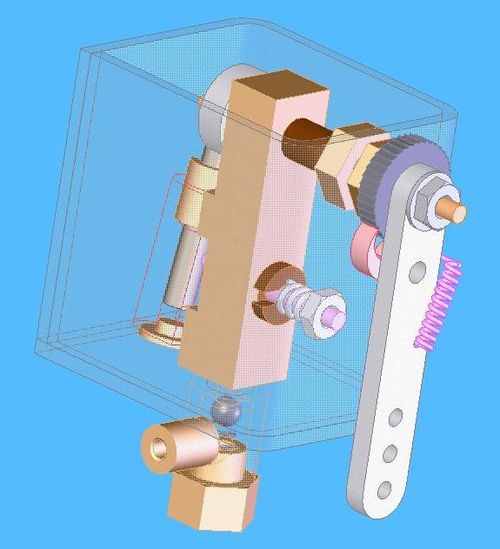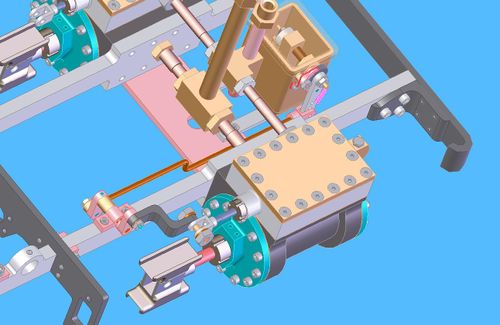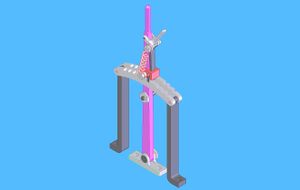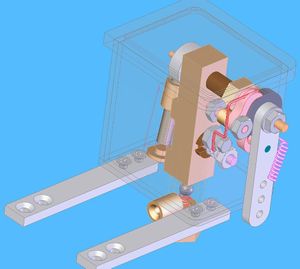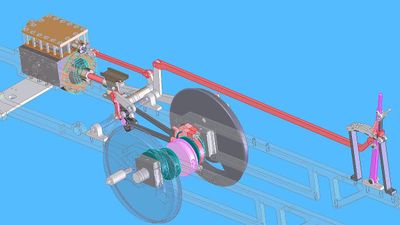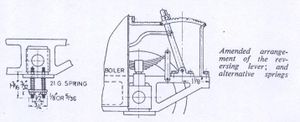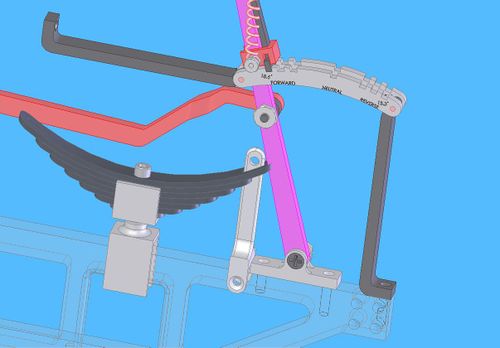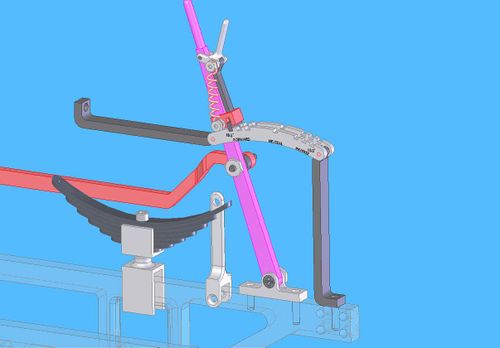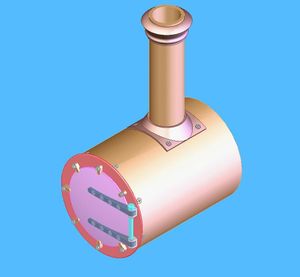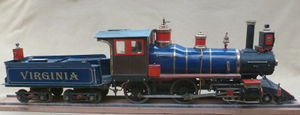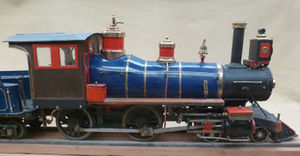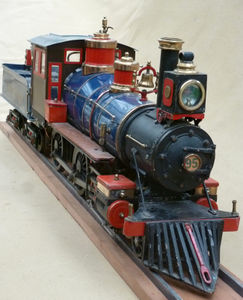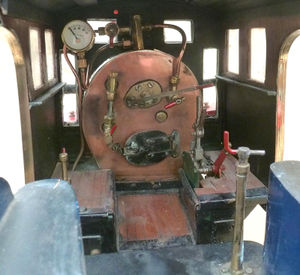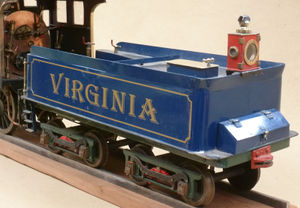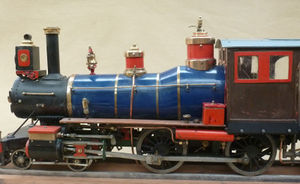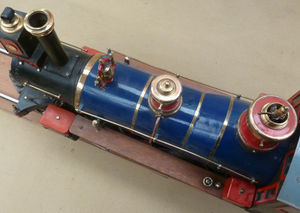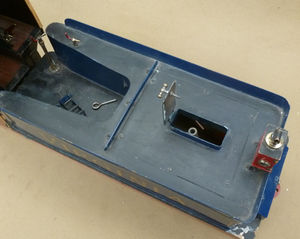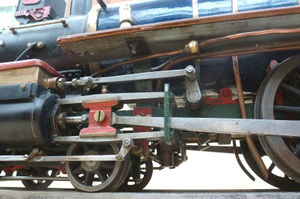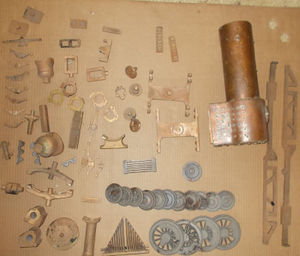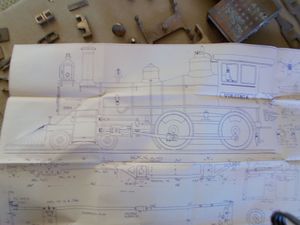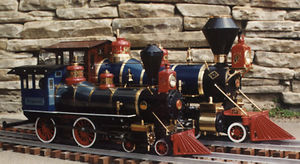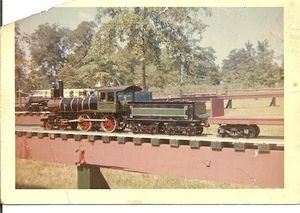LBSC's Virginia
Modeling LBSC's Virginia in SolidWorks
by Don Althouse
April 14, 2014
I have been attempting to make an electronic solid model of LBSC's Virginia from an article in Model Engineer written in 1956. This is by far one of the most complex and, shall I say, a bit hard to understand at times, projects I have found on the Internet to model.
I am a mechanical designer engineer that loves to work with SolidWorks (my design program) and have been working on this model since about the middle of February 2014. I was starting to model the mechanical lubricator and in doing a little research ran across the IBLS website. I thought you might enjoy seeing what I have accomplished so far, so I am attaching a JPEG picture of what I call the chassis.
Now that I have read a little more in the article, it seems my frames will have to be updated once again to accommodate the lubricator mounts and the linkage, a never ending process but one I am quite use to as I have done my fair share of drafting and design work over the years. I hope you enjoy the picture, modeling this train has kept me quite busy and for that I am very thankful.
April 16, 2014
I have several other LBSC articles as well. The TichSm, Rose, Juliet, Dot and Doris Class 5, all of which I believe are original Model Engineer articles that I have downloaded from LBSC Steam Engine Plans.
This website has been a great resource for me to get project plans to model and keep myself busy. I have modeled quite a few of the projects from this site, most of which dealt with steam, mainly different variations of steam engines, with the exception of an old CASE steam tractor model (see drawings below). I have been making these models for the past several years and was looking for something more involved when I ran across the LBSC article.
The more I get done with this LBSC model the more I am intrigued about Locomotives and the various ways they went about solving problems for various things. For instance the lubricator assembly, (not quite done and slightly modified, see attachment)what a great idea, so simple yet a very functional mechanical device, how cool!
My one concern about this endeavor is that my computer is very old as is my version of SolidWorks. I am running a 12 year old 32-bit Pentium 4 with an NVIDIA GeForce FX 5200 graphics card. Not the best system in the world for doing solid modeling. This will be by far the biggest and most complex model I have attempted to do on my system and I am not sure at this point if I will be able to get a full completed model due to lack of memory and the slow speed of my computer.
SolidWorks is a memory hog and there in lies my concern, the more I get done, the more memory is used. There are different things I can try to accomplish the task but at this point I really don't know if they will work or not, we will just have to see. I believe I can get all the sub-assemblies done though.
April 22, 2014
I finished the lubricator assembly and got the linkage for it done as well.
April 24, 2014
At this point I am writing a general outline of what I have done or should I say a general outline of the way LBSC designed a train. I have put together a PowerPoint Presentaion that I use on LinkedIn and update it when I get a few more assemblies done. I have included it in this article, below. At this point I have 175 unique parts and about 45 sub-assemblies. My intent with the presentation is to give a general outline from start to finish of the 1956 article.
May 5, 2014
As you know I ran into an issue with the Johnson Bar placement on the frame. I have contacted a friend about this and he said he would check his plans and get back to me. In the mean time I have moved on. I got the Johnson Bar modeled and updated the frame. I had to extend the rear of the frame by 1.5 inches so the Johnson Bar would not interfere with the suspension. In addition to this I also had to make an offset for the lever pin that attaches the Reach Rod to the Johnson Bar Lever so that it would not interfere with the Sector Supports. The reach Rod has also been extended by 1.5 inches.
I have also updated the Mechanical Lubricator Assembly which shows the missing pawl on the top of the box.
May 11, 2014
I have been playing around with the Stephenson valve gearing once again. I provided a JPEG, above, with it in place, but it never seemed to work right in SolidWorks so I decided to give it a better look and concentrate on the geometry of the whole valve train. I started my investigation by making sure that everything was in line and on center to the wheel axle, the expansion link and eccentrics to the expansion link were of particular concern. I could never get my model to be "fully defined". When I would attach a final piece, say the reversing arm to the reach rod, to connect the whole valve assembly SolidWorks would give me an error saying "over defined".
I finally narrowed things down to the center to center lengths of the eccentric rods. LBSC has his eccentric rod center-to-center lengths (from expansion link to the wheel axle) at 3-7/16 inches. The expansion link however has the eccentric connection holes on a radius of 3.5 inches to the wheel axle. That steenth of an inch (a shorter way to say sixteenth of an inch) is what was giving me all the problems. I am not sure if this would or would not cause any problems in the real world especially since there are other adjustments that could be made to try and compensate for this. SolidWorks however did alert me I think to what was a potential binding problem with the valve train linkage geometry. I am now fully defined and ready to start on the boiler.
I forgot to mention that I had to make the Reversing Arm 3/8" longer so that the Reach Rod from the Johnson Bar would not hit wheel with the Johnson Bar in full forward position.
May 12, 2014
Guess what I ran across while starting to read about the boiler? You got it, an addendum for the reversing lever. LBSC ran across the same problem I encountered with it. His fix is to attach the offending sector support in a horizontal position to the boiler above the suspension. Since my goal is to adhere to his design as close as possible I will have to redesign my redesign, so to speak. LOL. This should only effect the rear of the frame that I extended and the reach rod, should be an easy fix.
May 14, 2014
As you know I found an addendum for the reversing lever. Unfortunately after looking at it closer it is only for use with the alternative spring set up which uses a cast spring (shown on the left). I am using the working leaf spring set up (shown on the right). I have attached a JPEG of the two different suspensions from the article. Curly also points out the under-slung arrangement used on British Locomotives that he intends to use because it's easier to fit up. So a third alternate and then there is a fourth with spiral springs (shown with the addendum). Lots of options.
I tried the fix as per the addendum and ran into a few problems with my suspension.
- With the J Bar in the full forward position there is an interference with the leaf spring on the Working Suspension and the Lever of the J Bar. As far as I can tell if one were to use the Alternative or Cast Springs there may be just enough clearance but certainly not by much.
- As can be seen in the model there is also a problem with the mounting hole at the end of the frame for the Sector Support of the J Bar. The original frame drawing has 4 mounting holes at the rear for the Spacer to which the Draw Bar is attached. As can be seen one would be drilling through existing holes in the frame. There may be more about this in the article, but as of yet I have not run across anything.
In keeping with the addendum fix I have opted to extended the frame at the rear by 1/2". I have also increased the rear spacer width by 1/8" to 5/8". This will let me change the spacing of the mounting holes for the spacer bar from 1/4" to 3/8" and allow me to have a good enough clearance to tap and drill the necessary hole for the sector support between the two mounting holes of the spacer bar. As can be seen in the new model there is now sufficient clearance between the J Bar Lever and the Leaf Spring though it is only about 3/16" in the full forward position. And of course I had to update the Reach Rod as well.
By increasing the length of the rear of the frame by 1/2" I have no idea what the consequences of this will be, I can only hope they will be minimal. With all this said and the route that I am taking there are of course other alternatives one could use to solve this problem. I contacted a friend who actually built a real working model of Virginia and he offered three other alternatives.
- A. Mount the Johnson bar mechanism on the step in the cab floor which lifts it above the suspension (this is what I did). It means a bigger goose neck in the reach rod but no big deal and is actually easier to install than as designed.
- B. Turn the feet of the quadrant support inwards and move the whole mechanism back to the end of the frame.
- C. Make one part of the quadrant the support leg and pivot support for the Johnson bar. Many UK design, including Rob Roy, I think are designed this way making the mounting footprint a lot smaller and this should clear the suspension components.
A lot to take in this time, and I guess it just depends on what suspension system route one wants to pursue and the possible problems one may encounter along that path. In retrospect up to this point perhaps a different suspension would have been easier and less problematic. Fortunately for me I live in the electronic world where things are fairly easily changed with a click of mouse. Though I must say encountering problems such as these and going about finding solutions is really half the fun anyway.
I have already been giving a heads up about a possible boiler problems. Onward I say, lets see what I find.
May 26, 2014
I have been working on the boiler. I ran into quite a few issues with the firebox and throat plates and I have compiled a document describing these issues.
June 10, 2014
I have finished another installment of the boiler. I never realized how complicated Boilers are.
July 26, 2014
I performed a stress analysis on the boiler. This will be my second rendition of it, I was not looking at a few things that I should have been, i.e. respective x-y and z components of the stress. Instead, what I had done was to just look at the vonMises stress which is an average of all the x-y and z stresses as well as the x-y and z components of shear. Just because the average stress is below yield, does not necessarily mean that all the components are below yield. In the mean time I have finished the Smoke-box assembly and attached the JPEG.
October 15, 2014
I finished working on the throttle and super-heater and got them in place in the boiler. I am still working on the stress analysis.
December 2, 2014
I am still working on the stress analysis for the boiler, it seems the more I look into things with it, the more questions I have to try and find solutions for. I am up to almost 60 pages now and this is just for the open cylinder I am modeling for the cylindrical part of the outer wrap of the boiler. I can assure you that future endeavors will not be that long.
So in the mean time, I put together a model of the safety valve.
Happy holidays,
Don
January 2, 2015
Hope you had a very good holiday season. I have a couple of word documents for you, one is for the whistle valve turret and the other is for the grate and ash-pan. I found a problem with the placement of the turret, the back-head flange needs to be extended to accommodate the hole, you will see what I am talking about when you view.
Don
January 25, 2015
I finished up another few things for the boiler. I had to teach myself about routing which is another splendid tool that SolidWorks has for placing and routing tubing, piping and electrical wires. I am also getting to a point with the boiler where I am running out of available memory. As it stands the boiler assembly I have is about 6.3MB, so I may have to start thinking of new ways to accomplish the task. I still have plenty of ideas in that regard to try yet, so no worries as of now.
September 16, 2015
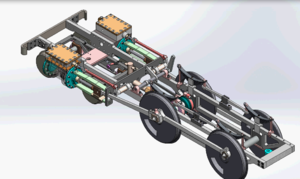
I had a chance to do a little work on the train and came up with a short avi clip of the wheels and steam cylinders in motion.
Also I have the solidworks stress analysis done for the outer wrap of the boiler, it is a very long report, but it is quite in depth about the workings of the SolidWorks stress analysis program and also shows what to look for and how to look for things.
I am in the midst of rebuilding the train when I get a chance. I have been working from home as of late and have a newer version of SolidWorks at my disposal to use, so instead of using 2007 I am now using 2014, the graphics are much much nicer.
October 12, 2015
Editor: Sorry to post this so late, it got "lost in the shuffle".
I have another installment to present, this one is for the water gauge, water level test valve and the boiler blow down valve.
I'm getting closer and closer, someday there may be a whole train. LOL
March 17, 2016
I have another installment for you for the Virginia. This one was kind of tough for me, I think the language that LB uses really threw me this time. All in all though I think I got through fairly well, let me know what you think.
April 29, 2016
I have finished another installment of Virginia and there were a few things to watch out for, at least with my model. I was going to combine erecting the boiler and fitting the pipework but I ran into some issues with the SolidWorks Routing add-in. These issues are lack of knowledge on my part about how to correctly set-up and use "Routing" to do the pipework. There may also be memory issues as well, regardless I shall endeavor to capture the needed knowledge to get this done, it may take a bit to accomplish.
October 21, 2016
Completed the pipework for Virginia and working on the cab, well, apron and whistle.
The Cab is done, next will be the cowcatcher and domes.
October 25, 2016
Another installment done for the cowcatcher, throttle dome and the sandbox.
Gallery of Models
eBay Listing
An LBSC Virginia listed on eBay, April 2014:
- A live steam, coal fired, American 4-4-0 Tender Locomotive. Built to the plans of the LBSC Virginia, likely in the 1970's and using factory castings. This is 3/4 inch scale and runs on 3-1/2 inch gauge track. The full set of large sheet original plans are include with the Engine. There is no boiler history or paperwork, it is copper, silver soldered multi-tubed type and engraved on the firebox side is, 'Q102 80lb sqi. The total length of the Locomotive and tender is 45 inches and height to the chimney is 11-3/4 inches. The usual fittings for this type, including, tender water boiler pump, axle water boiler pump, cab operated cylinder drain cocks, reverse lever, steam fed displacement oiler and tender brakes.
Reeves Castings
The following Reeves castings were posted on eBay in June, 2014.
Other Models
Ron Colonna's two LBSC Virginias. The one in front was the first locomotive built by Ron, and is in 3-1/2 inch gauge. The one in the background was Ron's scratch-built 4-3/4 inch gauge Virginia.
Ray Peck's LBSC Virginia at Pioneer Valley Live Steamers. Photo by Keith Taylor.

